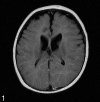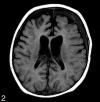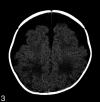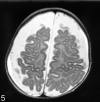Subdural hematomas in infants with benign enlargement of the subarachnoid spaces are not pathognomonic for child abuse
- PMID: 16971622
- PMCID: PMC8139783
Subdural hematomas in infants with benign enlargement of the subarachnoid spaces are not pathognomonic for child abuse
Abstract
Background and purpose: Patients who have benign enlargement of the subarachnoid spaces (BESS) have long been suspected of having an increased propensity for subdural hematomas either spontaneously or as a result of accidental injury. Subdural hematomas in infants are often equated with nonaccidental trauma (NAT). A better understanding of the clinical and imaging characteristics of subdural hematomas that occur either spontaneously or as a result of accidental trauma may help distinguish this group of patients from those who suffer subdural hematomas as a result of NAT. The purpose of this study is to describe the clinical and imaging characteristics of subdural hematomas that occur either spontaneously or as a result of accidental injury in infants with BESS.
Methods: We conducted a retrospective review of all patients with BESS complicated by subdural hematomas evaluated at a single institution from 1998 to 2004. Data concerning the patient's clinical presentation, physical findings, imaging, and management are described.
Results: During the study period, 7 patients with BESS complicated by subdural hematoma were identified. Their mean age at identification of the subdural hematoma was 7.4 months of age. In 5 cases, there was no recognized trauma before identification of the subdural hematoma. In 3 cases, baseline CT or MR imaging was available, showing prominent subarachnoid spaces without any evidence of subdural hemorrhage.
Conclusion: Although suspicious for NAT, subdural hematomas can occur in children either spontaneously or as a result of accidental trauma. Caution must be exercised when investigating for NAT based on the sole presence of subdural hematomas, especially in children who are otherwise well and who have BESS.
Figures





References
-
- Hamza M, Bodensteiner JB, Noorani PA, et al. Benign extracerebral fluid collections: a cause of macrocrania in infancy. Pediatr Neurol 1987;3:218–21 - PubMed
-
- Robertson WC Jr, Chun RW, Orrison WW, et al. Benign subdural collections of infancy. J Pediatr 1979;94:382–86 - PubMed
-
- Barkovich AJ. Pediatric Neuroimaging, 3rd ed. New York: Lippincott Williams & Wilkins;2000. .
-
- Azais A, Echenne B. Idiopathic subarachnoid space enlargement (benign external hydrocephalus) in infants. Ann Pediatr 1992;39:550–58 - PubMed
-
- Pittman T. Significance of a subdural hematoma in a child with external hydrocephalus. Pediatr Neurosurg 2003;39:57–59 - PubMed
MeSH terms
LinkOut - more resources
Full Text Sources
Medical
